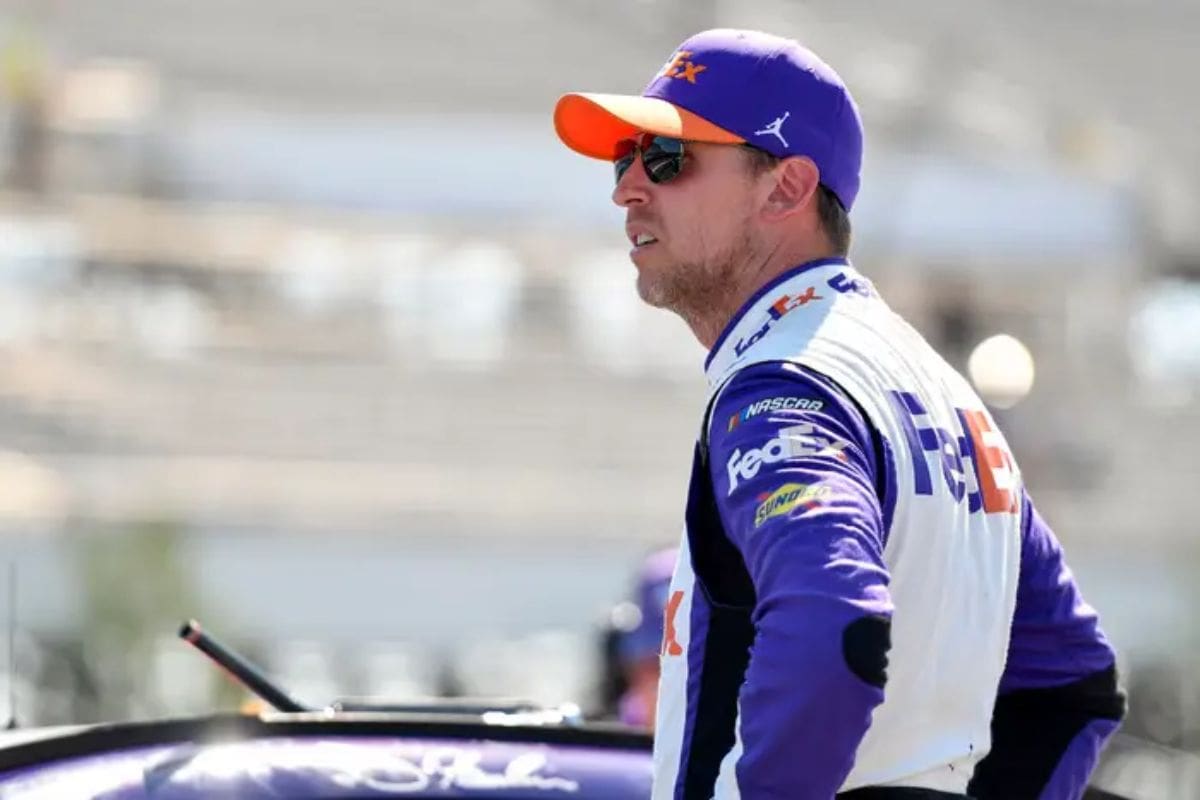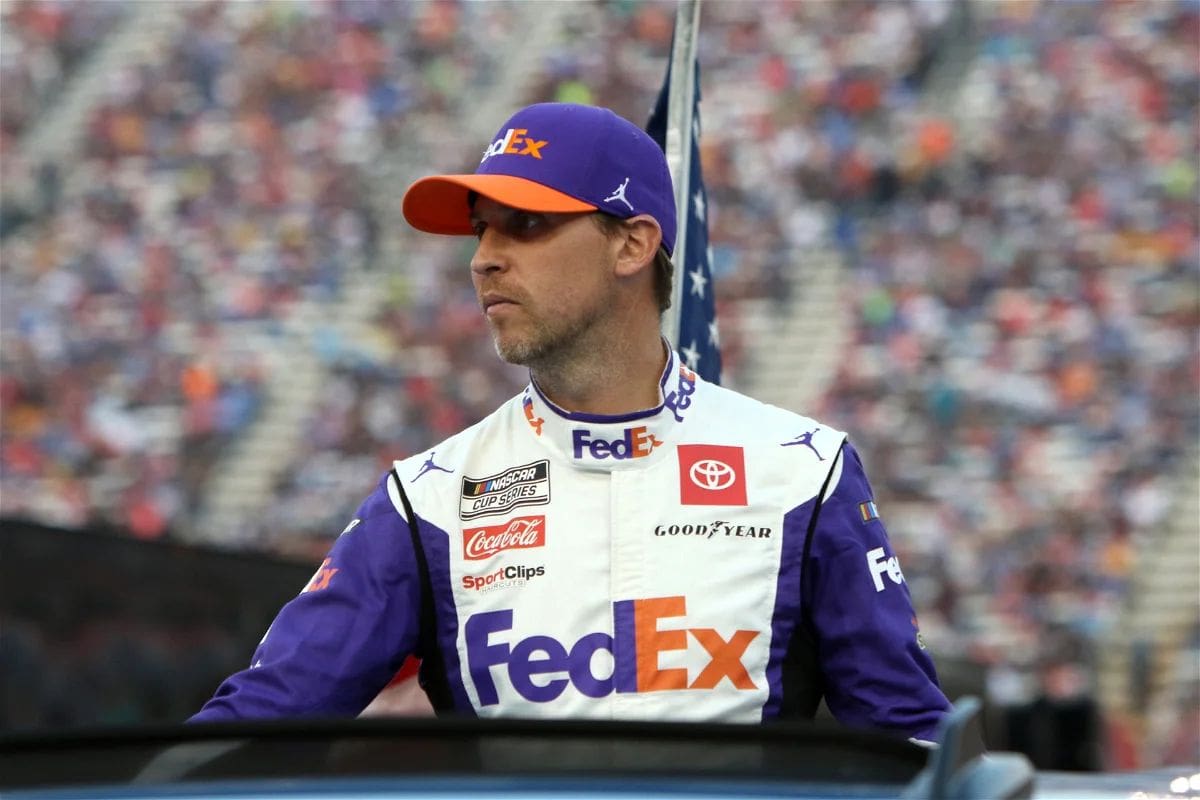Kevin Harvick Urges Denny Hamlin: Kevin Harvick‘s recent advice to Denny Hamlin, urging him to ‘stop the bleeding‘ to avoid a downturn related to Kyle Busch, highlights the critical nature of consistency in the high-stakes world of NASCAR. Hamlin’s misstep at Pocono Raceway presents the narrow margin for error in top-tier racing, where tactical precision and mental strength are dominating. Harvick’s comparison to Busch emphasizes the potential risks of losing momentum, and the need for Hamlin to adapt swiftly to maintain his competitive edge. What specific approaches might Hamlin adopt to avert this looming threat?
Key Takeaways
- Kevin Harvick emphasizes the need for Denny Hamlin to prevent a performance slump to avoid Kyle Busch’s struggles.
- Hamlin must maintain mental resilience and composure under pressure to sustain success.
- Strategic adaptation and incident management are crucial for Hamlin to dominate in familiar territories like Pocono Raceway.
- Consistent performance and quick adaptation to the Next Gen car’s unique characteristics are essential.
- Hamlin should capitalize on peak moments and halt performance declines to stay competitive.
Denny Hamlin’s Performance and Missed Opportunity
Denny Hamlin‘s runner-up finish at Pocono Raceway marked a notable missed chance for the seasoned driver. With a record of seven victories at this specific track, Hamlin is no stranger to win at Pocono. However, the elusive eighth win slipped through his fingers, as Ryan Blaney ultimately took the checkered flag. This near-miss is crucial not only for its immediate implications but also for its broader tactical impact on Hamlin’s season.
“The key to that usually becomes, who’s pushing you and how those pushes go. You just don’t want to be door-to-door with him. We’ve seen him put the #5 car in that position, the #1 car. That’s happened a couple of times at Pocono, but Denny Hamlin’s tough. When you look at Denny, they’ve had a rough 5 weeks as far as finishes go. When you look at Pocono and the finish that he had there, they had just a solid day. You heard him say it after the race, ‘We had a solid day from start to finish.’ They needed to stop the bleeding. It’s not that they have been running bad, but sometimes you just get in these funks where you can’t get those finishes.”-(kevin)
Despite already securing his playoff berth with three wins this season, the potential for an extra victory at Pocono would have further solidified Hamlin’s standing and momentum. Kevin Harvick, another veteran in the NASCAR scene, offered his perspective on what Hamlin could have done differently during his podcast, ‘Kevin Harvick’s Happy Hour.’ Harvick highlighted the critical nature of seizing every possible win, particularly when competing at a venue where past performance has been stellar.
Harvick’s analysis points to the strategic layers inherent in NASCAR, where each race serves as a building block toward the ultimate goal of a championship. For Hamlin, the missed chance at Pocono is a reminder of the fine margins that define success in this sport. Every decision, maneuver, and strategy must be executed with precision to capitalize on favorable conditions.
The insights from Harvick highlight the importance of not just participating but dominating, especially in familiar territory. Hamlin’s performance, while commendable, emphasizes the relentless pursuit of excellence required to maintain a competitive edge in NASCAR.
Race Details and Competitive Dynamics
Often marked by high stakes and razor-thin margins, the Pocono Raceway event showcased the intense competitive dynamics that define NASCAR’s elite racing. Ryan Blaney’s hard-fought victory was a reflection of his skill and strategic insight, especially as he faced relentless pressure from Denny Hamlin in the closing laps. The race was not just a contest of speed but a sophisticated interplay of tactics, split-second decisions, and psychological stamina.
As the race progressed particularly for Kyle Busch, who found himself in need of a win to secure a better standing in the playoff race. Busch’s season had been filled with challenges, making every lap at Pocono crucial for his championship aspirations. The competitive dynamics were further highlighted by the tactical maneuvers of leading drivers, with each decision carrying significant consequences for their playoff trajectories.
Hamlin’s chase of Blaney was indicative of the fierce competition at Pocono. His assertive yet calculated driving emphasized the razor-thin margin for error. Every turn, draft, and pit stop decision was analyzed, not just by the drivers but by their respective teams, who played a vital role in the overall strategy.
Kevin Harvick’s Analysis on Hamlin’s Performance
Kevin Harvick’s critique of Denny Hamlin’s recent performances highlights the vital need for tactical consistency and endurance in high-stakes racing. Harvick’s analysis comes in the aftermath of a series of challenging finishes for Hamlin, particularly leading up to the Pocono race. The veteran driver emphasized the strategic importance of halting this downward path to maintain competitive viability in the NASCAR Cup Series.
Harvick’s insights explore several critical aspects of Hamlin’s approach:
- Consistency in Performance: Harvick pointed out that Hamlin’s fluctuating results undermine his overall standing. In a sport where every race counts, ensuring a steady stream of strong finishes is essential.
- Strategic Adaptation: Harvick highlighted the need for Hamlin to adapt his strategies on the track, especially in high-pressure situations. Effective adaptation can mitigate the risks associated with aggressive driving, which has occasionally backfired for Hamlin.
- Incident Management: Reflecting on Hamlin’s history at Pocono, Harvick noted incidents involving Ross Chastain and Kyle Larson. By managing on-track conflicts more thoughtfully, Hamlin can avoid unnecessary setbacks.
- Mental Resilience: Harvick emphasized the psychological aspect of racing, stressing the importance of mental toughness. Hamlin’s ability to maintain focus and composure under pressure could make a significant difference in reversing his fortunes.
Kyle Busch’s Struggles and Harvick’s Comparison
Drawing a parallel between the struggles of Denny Hamlin and Kyle Busch, Harvick highlighted the critical need for consistent performance and mental strength in the face of challenges. Harvick’s comparison is particularly considering Kyle Busch’s recent setbacks, notably at Pocono, where Busch encountered further difficulties.
Despite enduring incidents involving Corey LaJoie, Busch demonstrated admirable composure post-race, focusing on the inherent competitiveness of the sport rather than giving in to frustration. Harvick’s observations underscore the importance of maintaining mental toughness and focus, even when faced with persistent challenges.
Busch’s current situation serves as a cautionary tale for Hamlin, emphasizing that a series of below-average performances can quickly spiral into a prolonged slump if not addressed promptly. Harvick’s advice to Hamlin embodies a proactive approach, urging him to ‘stop the bleeding‘ before it mirrors the prolonged struggles experienced by Busch.
Busch’s demeanor post-Pocono also reveals an underlying determination that is crucial for any driver aiming to rebound from a series of setbacks. This mindset is something Harvick implicitly advises Hamlin to adopt. Mental strength, coupled with tactical adjustments on and off the track, is pivotal in reversing the momentum of a downward path.
Harvick’s comparison sheds light on the fine line between resilience and decline in the high-stakes world of racing. For Hamlin, the warning is clear: without immediate and effective intervention, the path can quickly mirror Busch’s ongoing challenges. Harvick’s insights offer a roadmap to not only halt a potential decline but also to foster a resurgence in performance through steady focus and adaptability.
Insights on Competition and Next Gen Car Challenges
Adapting to the Next Gen car has introduced a unique set of challenges that highlight the competitive balance and tactical intricacy in contemporary racing. Kevin Harvick’s insights reveal the challenges that drivers like Christopher Bell face, showcasing how the Next Gen car’s design and performance capabilities impact race strategies and outcomes. This modern era of NASCAR demands versatility and adaptability from drivers, emphasizing the unpredictable nature of mid-season racing where performance fluctuations are routine.
Harvick’s observations illuminate several key aspects:
- Enhanced Competitive Balance: The Next Gen car’s standardized components have evened the playing field, making it more difficult for any single team to maintain a consistent advantage.
- Strategic Flexibility: With the new car, race strategies have become more adaptable, requiring teams to constantly adjust their approaches to race-day conditions and rival tactics.
- Performance Peaks and Troughs: Drivers face notable performance fluctuations, requiring a resilient mindset and the ability to capitalize on opportunities as they present themselves.
- Technical Adjustment: Mastery of the Next Gen car’s unique handling and aerodynamic characteristics is essential, necessitating a continuous commitment to learning and adaptation.
Harvick’s analysis emphasizes the significance of quickly adapting to the changing competitive landscape. This era’s racing environment is less forgiving, with small margins often determining success or failure. As drivers navigate these details, the ability to halt declines during downturns and seize moments of peak performance becomes essential.
News in Brief: Kevin Harvick Urges Denny Hamlin
Kevin Harvick’s counsel to Denny Hamlin highlights the crucial need for consistency and mental fortitude in the high-pressure setting of NASCAR.
By acknowledging and handling performance-related issues promptly, Hamlin can steer clear of the setbacks encountered by Kyle Busch.
In the realm of competitive dynamics and the obstacles presented by the Next Gen car, tactical adjustment and efficient incident management are key.
Maintaining success in this competitive environment requires a focus on performance and flexibility.
ALSO READ: Kevin Harvick Surprised by Chicago Race: From “Dumbest Thing” to Newfound Love



